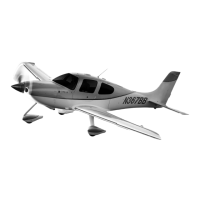4-20 P/N 13772-002
Section 4 Cirrus Design
Normal Procedures SR22
Landing
• Caution •
Landings should be made with full flaps. Landings with less
than full flaps are recommended only if the flaps fail to deploy
or to extend the aircraft’s glide distance due to engine
malfunction. Landings with flaps at 50% or 0%; power should
be used to achieve a normal glide path and low descent rate.
Flare should be minimized.
Normal Landing
Normal landings are made with full flaps with power on or off. Surface
winds and air turbulence are usually the primary factors in determining
the most comfortable approach speeds.
Actual touchdown should be made with power off and on the main
wheels first to reduce the landing speed and subsequent need for
braking. Gently lower the nose wheel to the runway after airplane
speed has diminished. This is especially important for rough or soft
field landings.
Short Field Landing
For a short field landing in smooth air conditions, make an approach at
77 KIAS with full flaps using enough power to control the glide path
(slightly higher approach speeds should be used under turbulent air
conditions). After all approach obstacles are cleared, progressively
reduce power to reach idle just before touchdown and maintain the
approach speed by lowering the nose of the airplane. Touchdown
should be made power-off and on the main wheels first. Immediately
after touchdown, lower the nose wheel and apply braking as required.
For maximum brake effectiveness, retract the flaps, hold the control
yoke full back, and apply maximum brake pressure without skidding.
Crosswind Landing
Normal crosswind landings are made with full flaps. Avoid prolonged
slips. After touchdown, hold a straight course with rudder and brakes
as required.
The maximum allowable crosswind velocity is dependent upon pilot
capability as well as aircraft limitations. Operation in direct crosswinds
of 20 knots has been demonstrated.
Reissue A

